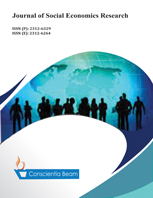Modelling and mapping the poverty levels with applied spatial regression model in South Sulawesi province of Indonesia
DOI:
https://doi.org/10.18488/35.v11i1.3608Abstract
The focus of this study is to model the poverty rate using a statistical approach and then carry out a spatial mapping of the poverty rate in regencies and cities in South Sulawesi Province. This study is important to research so that it becomes a reference for the government in formulating policy analysis on poverty alleviation and its sustainability. The method used is the spatial regression model with cross-sectional data, using R software as a tool for analyzing research data. The findings show that the poverty levels in the regencies and cities of South Sulawesi province are randomly distributed and have a dispersed pattern. The significance of the response variable under analysis has an impact on this. In addition, the best model was obtained, namely the Spatial Error Model (SEM) model with the smallest p-value and a confidence level of 86%. The results of the hot-spot and cold-spot analysis show that the concentration of poverty levels is still focused on the southern region in the hot-spot area (red color), namely Bantaeng Regency, Jeneponto Regency, Takalar Regency, Gowa Regency, Makassar City, Maros Regency, Sinjai Regency, and Barru Regency. The implications for the community in the hot-spot category area are that special attention is needed from the government and stakeholders to be directly involved in improving the poverty level that occurs in the community through sustainable poverty alleviation programs.

